HRM: Strategic Partnership, Employee Development & Recruitment Report
VerifiedAdded on 2022/09/05
|9
|2773
|24
Report
AI Summary
This report provides an overview of Human Resource Management (HRM), emphasizing its strategic role in organizations. It defines HRM as the practice of recruiting, hiring, deploying, and managing employees to maximize return on investment. The report discusses the role of HR as a strategic partner, focusing on aligning HR practices with organizational objectives. Key HRM functions such as recruiting, selecting, training, developing, and rewarding employees are explored, highlighting the importance of integration and teamwork. It covers human resource planning, including job analysis, job descriptions, and HR forecasting, to balance human resource supply and demand. The report also discusses recruitment strategies, both internal and external, along with their advantages and disadvantages. Furthermore, it delves into human resource development (HRD) methods, including on-the-job training, job rotation, coaching, mentoring, apprenticeships, and internships, aimed at enhancing employee skills and organizational capabilities. The content aligns with Chapter 12 readings and slides, offering practical insights into HRM practices.
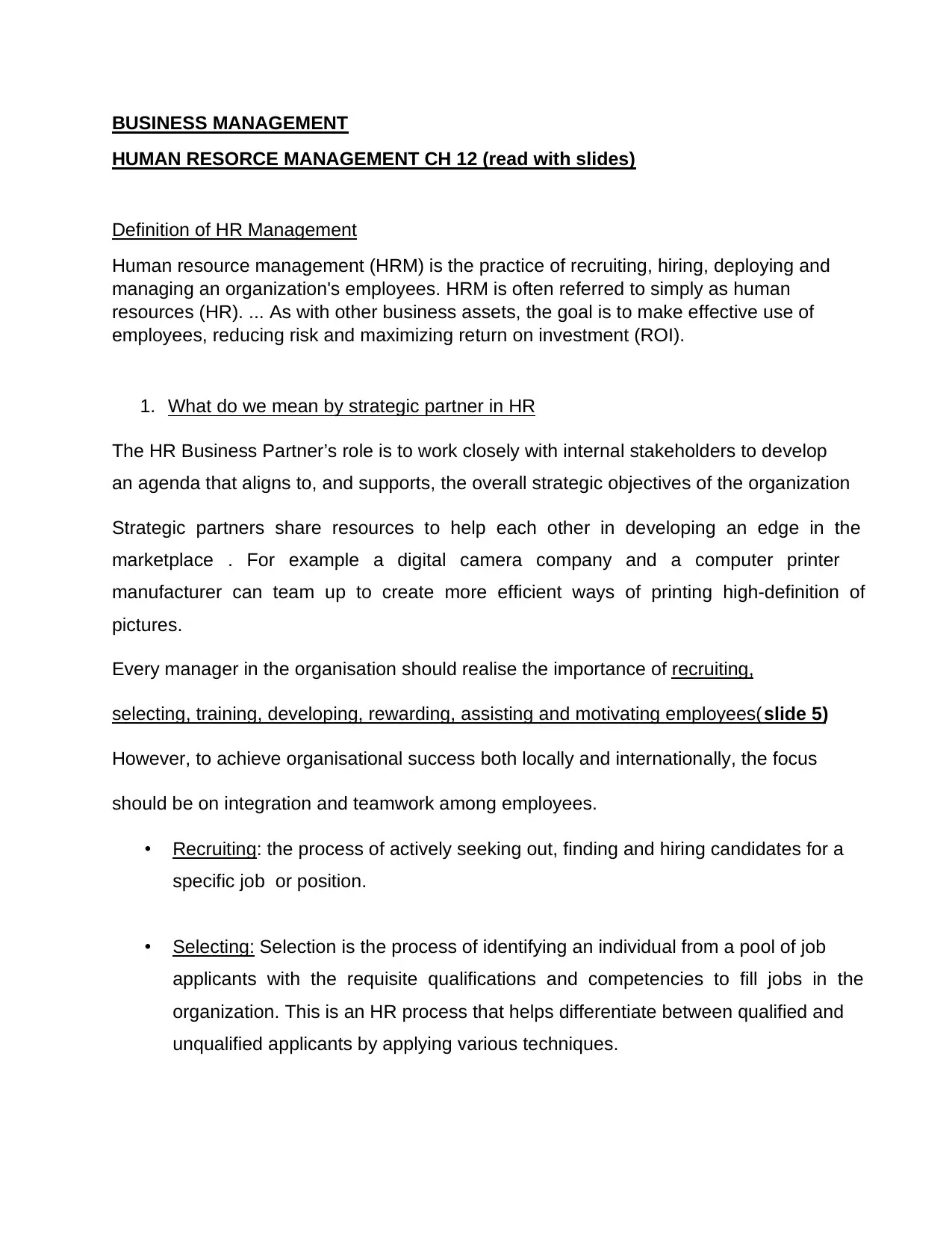
BUSINESS MANAGEMENT
HUMAN RESORCE MANAGEMENT CH 12 (read with slides)
Definition of HR Management
Human resource management (HRM) is the practice of recruiting, hiring, deploying and
managing an organization's employees. HRM is often referred to simply as human
resources (HR). ... As with other business assets, the goal is to make effective use of
employees, reducing risk and maximizing return on investment (ROI).
1. What do we mean by strategic partner in HR
The HR Business Partner’s role is to work closely with internal stakeholders to develop
an agenda that aligns to, and supports, the overall strategic objectives of the organization
Strategic partners share resources to help each other in developing an edge in the
marketplace . For example a digital camera company and a computer printer
manufacturer can team up to create more efficient ways of printing high-definition of
pictures.
Every manager in the organisation should realise the importance of recruiting,
selecting, training, developing, rewarding, assisting and motivating employees(slide 5)
However, to achieve organisational success both locally and internationally, the focus
should be on integration and teamwork among employees.
• Recruiting: the process of actively seeking out, finding and hiring candidates for a
specific job or position.
• Selecting: Selection is the process of identifying an individual from a pool of job
applicants with the requisite qualifications and competencies to fill jobs in the
organization. This is an HR process that helps differentiate between qualified and
unqualified applicants by applying various techniques.
HUMAN RESORCE MANAGEMENT CH 12 (read with slides)
Definition of HR Management
Human resource management (HRM) is the practice of recruiting, hiring, deploying and
managing an organization's employees. HRM is often referred to simply as human
resources (HR). ... As with other business assets, the goal is to make effective use of
employees, reducing risk and maximizing return on investment (ROI).
1. What do we mean by strategic partner in HR
The HR Business Partner’s role is to work closely with internal stakeholders to develop
an agenda that aligns to, and supports, the overall strategic objectives of the organization
Strategic partners share resources to help each other in developing an edge in the
marketplace . For example a digital camera company and a computer printer
manufacturer can team up to create more efficient ways of printing high-definition of
pictures.
Every manager in the organisation should realise the importance of recruiting,
selecting, training, developing, rewarding, assisting and motivating employees(slide 5)
However, to achieve organisational success both locally and internationally, the focus
should be on integration and teamwork among employees.
• Recruiting: the process of actively seeking out, finding and hiring candidates for a
specific job or position.
• Selecting: Selection is the process of identifying an individual from a pool of job
applicants with the requisite qualifications and competencies to fill jobs in the
organization. This is an HR process that helps differentiate between qualified and
unqualified applicants by applying various techniques.
Paraphrase This Document
Need a fresh take? Get an instant paraphrase of this document with our AI Paraphraser
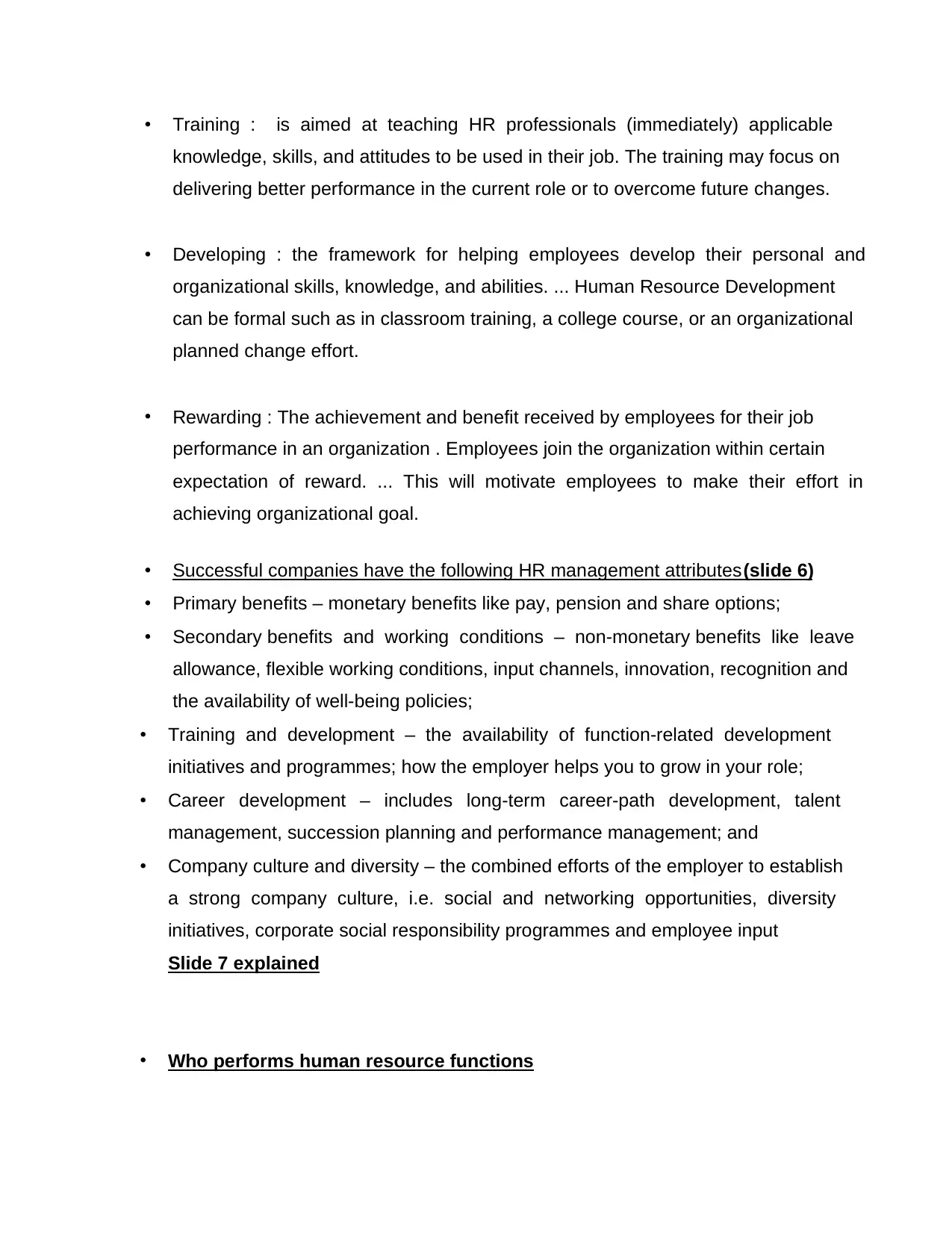
• Training : is aimed at teaching HR professionals (immediately) applicable
knowledge, skills, and attitudes to be used in their job. The training may focus on
delivering better performance in the current role or to overcome future changes.
• Developing : the framework for helping employees develop their personal and
organizational skills, knowledge, and abilities. ... Human Resource Development
can be formal such as in classroom training, a college course, or an organizational
planned change effort.
• Rewarding : The achievement and benefit received by employees for their job
performance in an organization . Employees join the organization within certain
expectation of reward. ... This will motivate employees to make their effort in
achieving organizational goal.
• Successful companies have the following HR management attributes(slide 6)
• Primary benefits – monetary benefits like pay, pension and share options;
• Secondary benefits and working conditions – non-monetary benefits like leave
allowance, flexible working conditions, input channels, innovation, recognition and
the availability of well-being policies;
• Training and development – the availability of function-related development
initiatives and programmes; how the employer helps you to grow in your role;
• Career development – includes long-term career-path development, talent
management, succession planning and performance management; and
• Company culture and diversity – the combined efforts of the employer to establish
a strong company culture, i.e. social and networking opportunities, diversity
initiatives, corporate social responsibility programmes and employee input
Slide 7 explained
• Who performs human resource functions
knowledge, skills, and attitudes to be used in their job. The training may focus on
delivering better performance in the current role or to overcome future changes.
• Developing : the framework for helping employees develop their personal and
organizational skills, knowledge, and abilities. ... Human Resource Development
can be formal such as in classroom training, a college course, or an organizational
planned change effort.
• Rewarding : The achievement and benefit received by employees for their job
performance in an organization . Employees join the organization within certain
expectation of reward. ... This will motivate employees to make their effort in
achieving organizational goal.
• Successful companies have the following HR management attributes(slide 6)
• Primary benefits – monetary benefits like pay, pension and share options;
• Secondary benefits and working conditions – non-monetary benefits like leave
allowance, flexible working conditions, input channels, innovation, recognition and
the availability of well-being policies;
• Training and development – the availability of function-related development
initiatives and programmes; how the employer helps you to grow in your role;
• Career development – includes long-term career-path development, talent
management, succession planning and performance management; and
• Company culture and diversity – the combined efforts of the employer to establish
a strong company culture, i.e. social and networking opportunities, diversity
initiatives, corporate social responsibility programmes and employee input
Slide 7 explained
• Who performs human resource functions
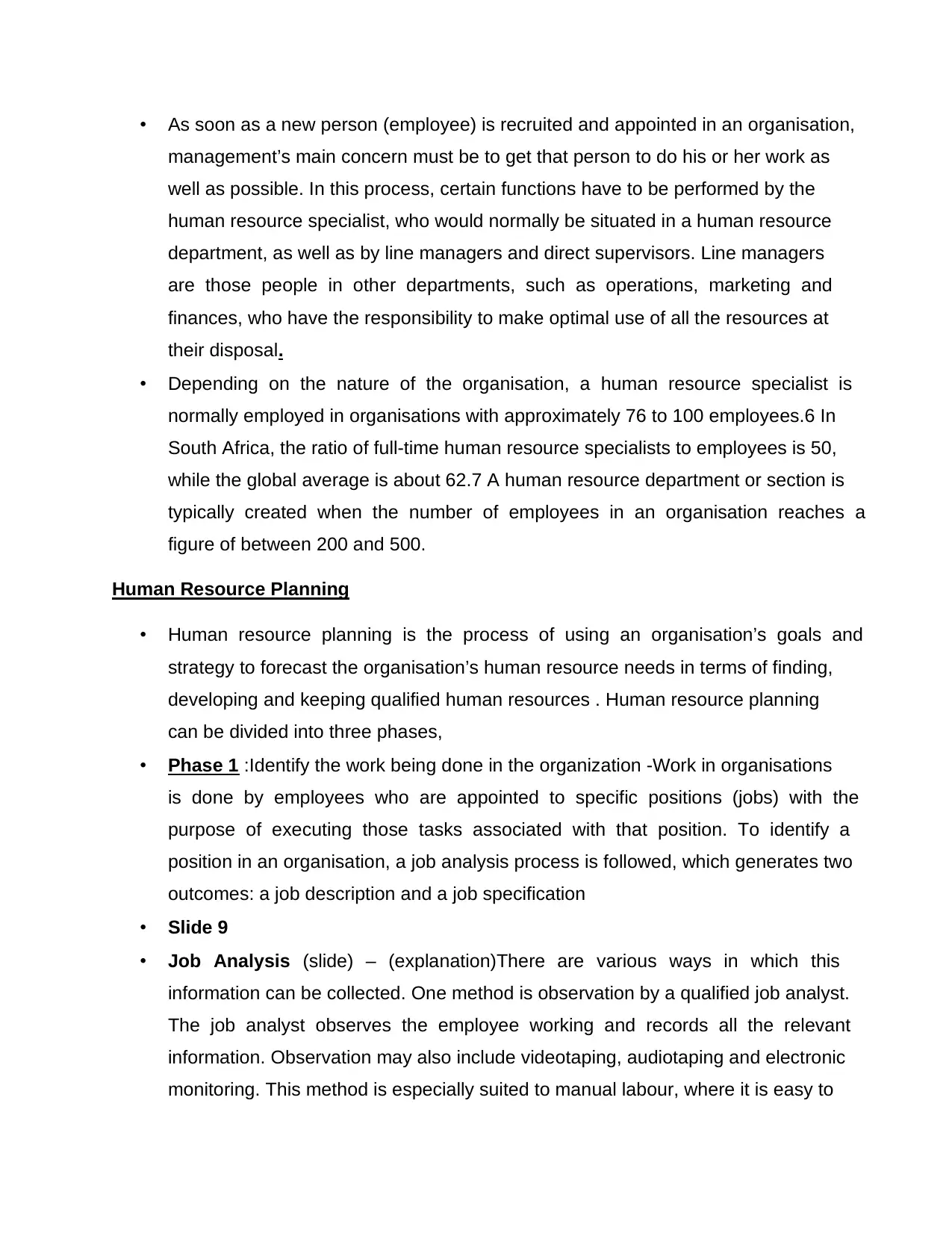
• As soon as a new person (employee) is recruited and appointed in an organisation,
management’s main concern must be to get that person to do his or her work as
well as possible. In this process, certain functions have to be performed by the
human resource specialist, who would normally be situated in a human resource
department, as well as by line managers and direct supervisors. Line managers
are those people in other departments, such as operations, marketing and
finances, who have the responsibility to make optimal use of all the resources at
their disposal.
• Depending on the nature of the organisation, a human resource specialist is
normally employed in organisations with approximately 76 to 100 employees.6 In
South Africa, the ratio of full-time human resource specialists to employees is 50,
while the global average is about 62.7 A human resource department or section is
typically created when the number of employees in an organisation reaches a
figure of between 200 and 500.
Human Resource Planning
• Human resource planning is the process of using an organisation’s goals and
strategy to forecast the organisation’s human resource needs in terms of finding,
developing and keeping qualified human resources . Human resource planning
can be divided into three phases,
• Phase 1 :Identify the work being done in the organization -Work in organisations
is done by employees who are appointed to specific positions (jobs) with the
purpose of executing those tasks associated with that position. To identify a
position in an organisation, a job analysis process is followed, which generates two
outcomes: a job description and a job specification
• Slide 9
• Job Analysis (slide) – (explanation)There are various ways in which this
information can be collected. One method is observation by a qualified job analyst.
The job analyst observes the employee working and records all the relevant
information. Observation may also include videotaping, audiotaping and electronic
monitoring. This method is especially suited to manual labour, where it is easy to
management’s main concern must be to get that person to do his or her work as
well as possible. In this process, certain functions have to be performed by the
human resource specialist, who would normally be situated in a human resource
department, as well as by line managers and direct supervisors. Line managers
are those people in other departments, such as operations, marketing and
finances, who have the responsibility to make optimal use of all the resources at
their disposal.
• Depending on the nature of the organisation, a human resource specialist is
normally employed in organisations with approximately 76 to 100 employees.6 In
South Africa, the ratio of full-time human resource specialists to employees is 50,
while the global average is about 62.7 A human resource department or section is
typically created when the number of employees in an organisation reaches a
figure of between 200 and 500.
Human Resource Planning
• Human resource planning is the process of using an organisation’s goals and
strategy to forecast the organisation’s human resource needs in terms of finding,
developing and keeping qualified human resources . Human resource planning
can be divided into three phases,
• Phase 1 :Identify the work being done in the organization -Work in organisations
is done by employees who are appointed to specific positions (jobs) with the
purpose of executing those tasks associated with that position. To identify a
position in an organisation, a job analysis process is followed, which generates two
outcomes: a job description and a job specification
• Slide 9
• Job Analysis (slide) – (explanation)There are various ways in which this
information can be collected. One method is observation by a qualified job analyst.
The job analyst observes the employee working and records all the relevant
information. Observation may also include videotaping, audiotaping and electronic
monitoring. This method is especially suited to manual labour, where it is easy to
⊘ This is a preview!⊘
Do you want full access?
Subscribe today to unlock all pages.

Trusted by 1+ million students worldwide
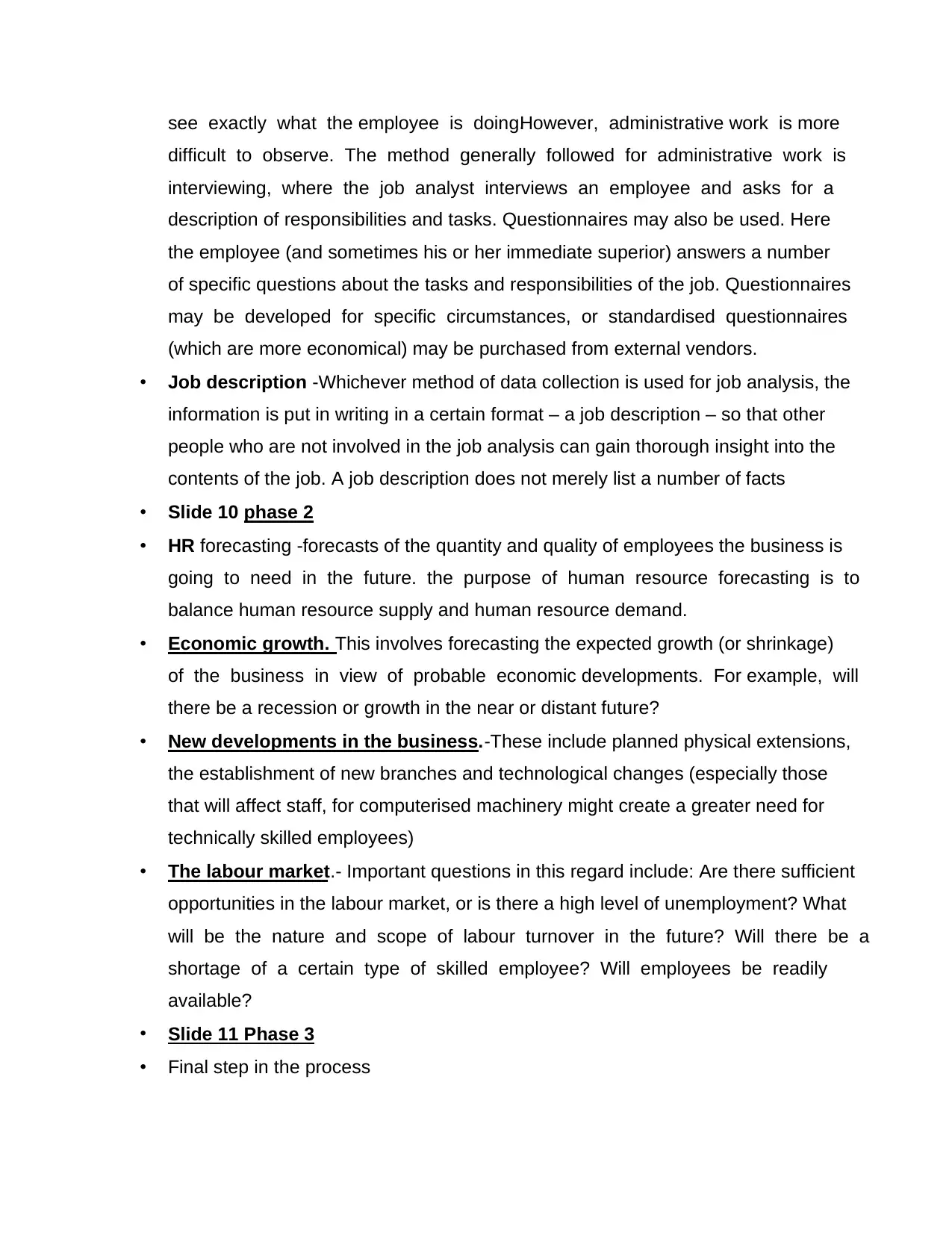
see exactly what the employee is doing.However, administrative work is more
difficult to observe. The method generally followed for administrative work is
interviewing, where the job analyst interviews an employee and asks for a
description of responsibilities and tasks. Questionnaires may also be used. Here
the employee (and sometimes his or her immediate superior) answers a number
of specific questions about the tasks and responsibilities of the job. Questionnaires
may be developed for specific circumstances, or standardised questionnaires
(which are more economical) may be purchased from external vendors.
• Job description -Whichever method of data collection is used for job analysis, the
information is put in writing in a certain format – a job description – so that other
people who are not involved in the job analysis can gain thorough insight into the
contents of the job. A job description does not merely list a number of facts
• Slide 10 phase 2
• HR forecasting -forecasts of the quantity and quality of employees the business is
going to need in the future. the purpose of human resource forecasting is to
balance human resource supply and human resource demand.
• Economic growth. This involves forecasting the expected growth (or shrinkage)
of the business in view of probable economic developments. For example, will
there be a recession or growth in the near or distant future?
• New developments in the business.-These include planned physical extensions,
the establishment of new branches and technological changes (especially those
that will affect staff, for computerised machinery might create a greater need for
technically skilled employees)
• The labour market.- Important questions in this regard include: Are there sufficient
opportunities in the labour market, or is there a high level of unemployment? What
will be the nature and scope of labour turnover in the future? Will there be a
shortage of a certain type of skilled employee? Will employees be readily
available?
• Slide 11 Phase 3
• Final step in the process
difficult to observe. The method generally followed for administrative work is
interviewing, where the job analyst interviews an employee and asks for a
description of responsibilities and tasks. Questionnaires may also be used. Here
the employee (and sometimes his or her immediate superior) answers a number
of specific questions about the tasks and responsibilities of the job. Questionnaires
may be developed for specific circumstances, or standardised questionnaires
(which are more economical) may be purchased from external vendors.
• Job description -Whichever method of data collection is used for job analysis, the
information is put in writing in a certain format – a job description – so that other
people who are not involved in the job analysis can gain thorough insight into the
contents of the job. A job description does not merely list a number of facts
• Slide 10 phase 2
• HR forecasting -forecasts of the quantity and quality of employees the business is
going to need in the future. the purpose of human resource forecasting is to
balance human resource supply and human resource demand.
• Economic growth. This involves forecasting the expected growth (or shrinkage)
of the business in view of probable economic developments. For example, will
there be a recession or growth in the near or distant future?
• New developments in the business.-These include planned physical extensions,
the establishment of new branches and technological changes (especially those
that will affect staff, for computerised machinery might create a greater need for
technically skilled employees)
• The labour market.- Important questions in this regard include: Are there sufficient
opportunities in the labour market, or is there a high level of unemployment? What
will be the nature and scope of labour turnover in the future? Will there be a
shortage of a certain type of skilled employee? Will employees be readily
available?
• Slide 11 Phase 3
• Final step in the process
Paraphrase This Document
Need a fresh take? Get an instant paraphrase of this document with our AI Paraphraser
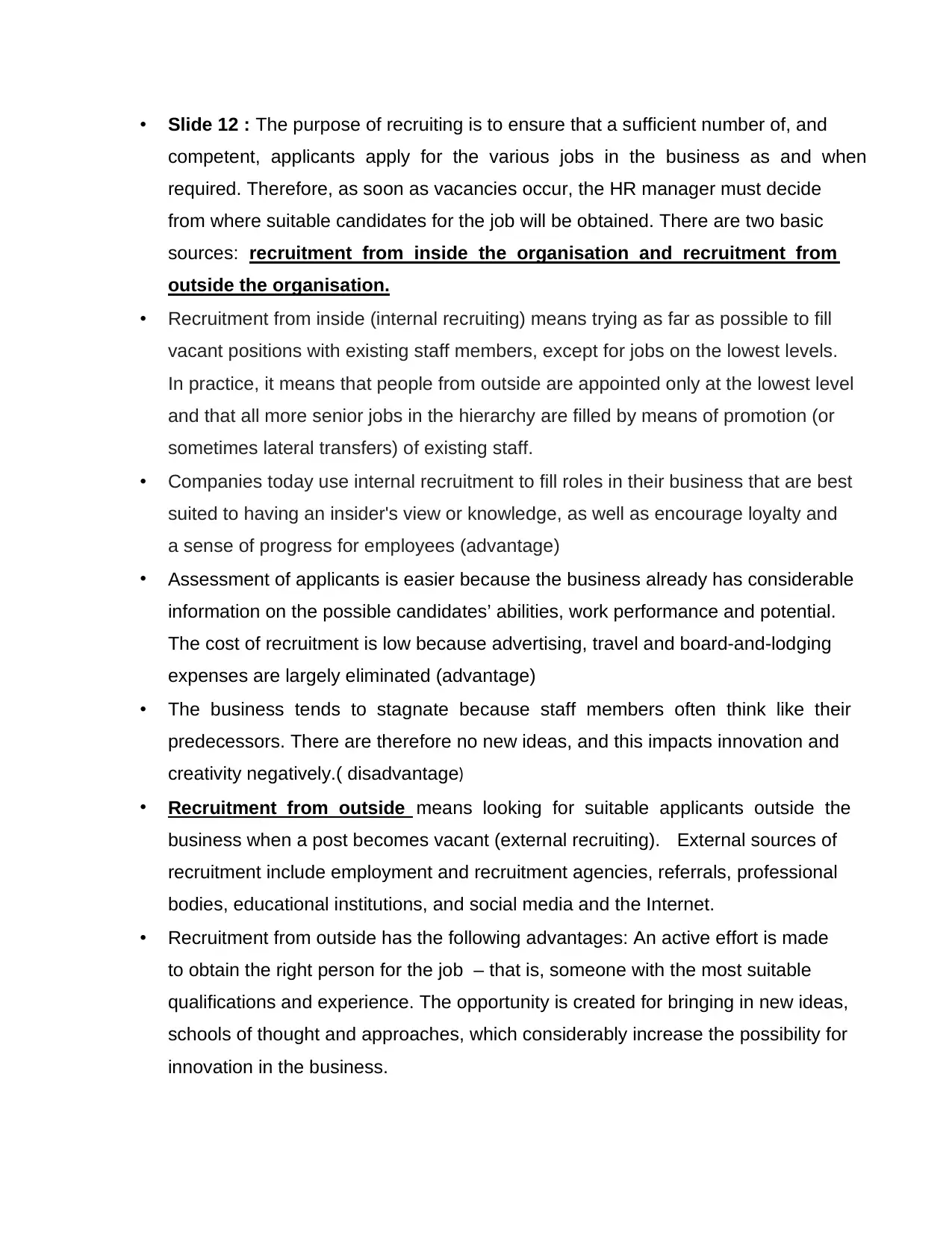
• Slide 12 : The purpose of recruiting is to ensure that a sufficient number of, and
competent, applicants apply for the various jobs in the business as and when
required. Therefore, as soon as vacancies occur, the HR manager must decide
from where suitable candidates for the job will be obtained. There are two basic
sources: recruitment from inside the organisation and recruitment from
outside the organisation.
• Recruitment from inside (internal recruiting) means trying as far as possible to fill
vacant positions with existing staff members, except for jobs on the lowest levels.
In practice, it means that people from outside are appointed only at the lowest level
and that all more senior jobs in the hierarchy are filled by means of promotion (or
sometimes lateral transfers) of existing staff.
• Companies today use internal recruitment to fill roles in their business that are best
suited to having an insider's view or knowledge, as well as encourage loyalty and
a sense of progress for employees (advantage)
• Assessment of applicants is easier because the business already has considerable
information on the possible candidates’ abilities, work performance and potential.
The cost of recruitment is low because advertising, travel and board-and-lodging
expenses are largely eliminated (advantage)
• The business tends to stagnate because staff members often think like their
predecessors. There are therefore no new ideas, and this impacts innovation and
creativity negatively.( disadvantage)
• Recruitment from outside means looking for suitable applicants outside the
business when a post becomes vacant (external recruiting). External sources of
recruitment include employment and recruitment agencies, referrals, professional
bodies, educational institutions, and social media and the Internet.
• Recruitment from outside has the following advantages: An active effort is made
to obtain the right person for the job – that is, someone with the most suitable
qualifications and experience. The opportunity is created for bringing in new ideas,
schools of thought and approaches, which considerably increase the possibility for
innovation in the business.
competent, applicants apply for the various jobs in the business as and when
required. Therefore, as soon as vacancies occur, the HR manager must decide
from where suitable candidates for the job will be obtained. There are two basic
sources: recruitment from inside the organisation and recruitment from
outside the organisation.
• Recruitment from inside (internal recruiting) means trying as far as possible to fill
vacant positions with existing staff members, except for jobs on the lowest levels.
In practice, it means that people from outside are appointed only at the lowest level
and that all more senior jobs in the hierarchy are filled by means of promotion (or
sometimes lateral transfers) of existing staff.
• Companies today use internal recruitment to fill roles in their business that are best
suited to having an insider's view or knowledge, as well as encourage loyalty and
a sense of progress for employees (advantage)
• Assessment of applicants is easier because the business already has considerable
information on the possible candidates’ abilities, work performance and potential.
The cost of recruitment is low because advertising, travel and board-and-lodging
expenses are largely eliminated (advantage)
• The business tends to stagnate because staff members often think like their
predecessors. There are therefore no new ideas, and this impacts innovation and
creativity negatively.( disadvantage)
• Recruitment from outside means looking for suitable applicants outside the
business when a post becomes vacant (external recruiting). External sources of
recruitment include employment and recruitment agencies, referrals, professional
bodies, educational institutions, and social media and the Internet.
• Recruitment from outside has the following advantages: An active effort is made
to obtain the right person for the job – that is, someone with the most suitable
qualifications and experience. The opportunity is created for bringing in new ideas,
schools of thought and approaches, which considerably increase the possibility for
innovation in the business.
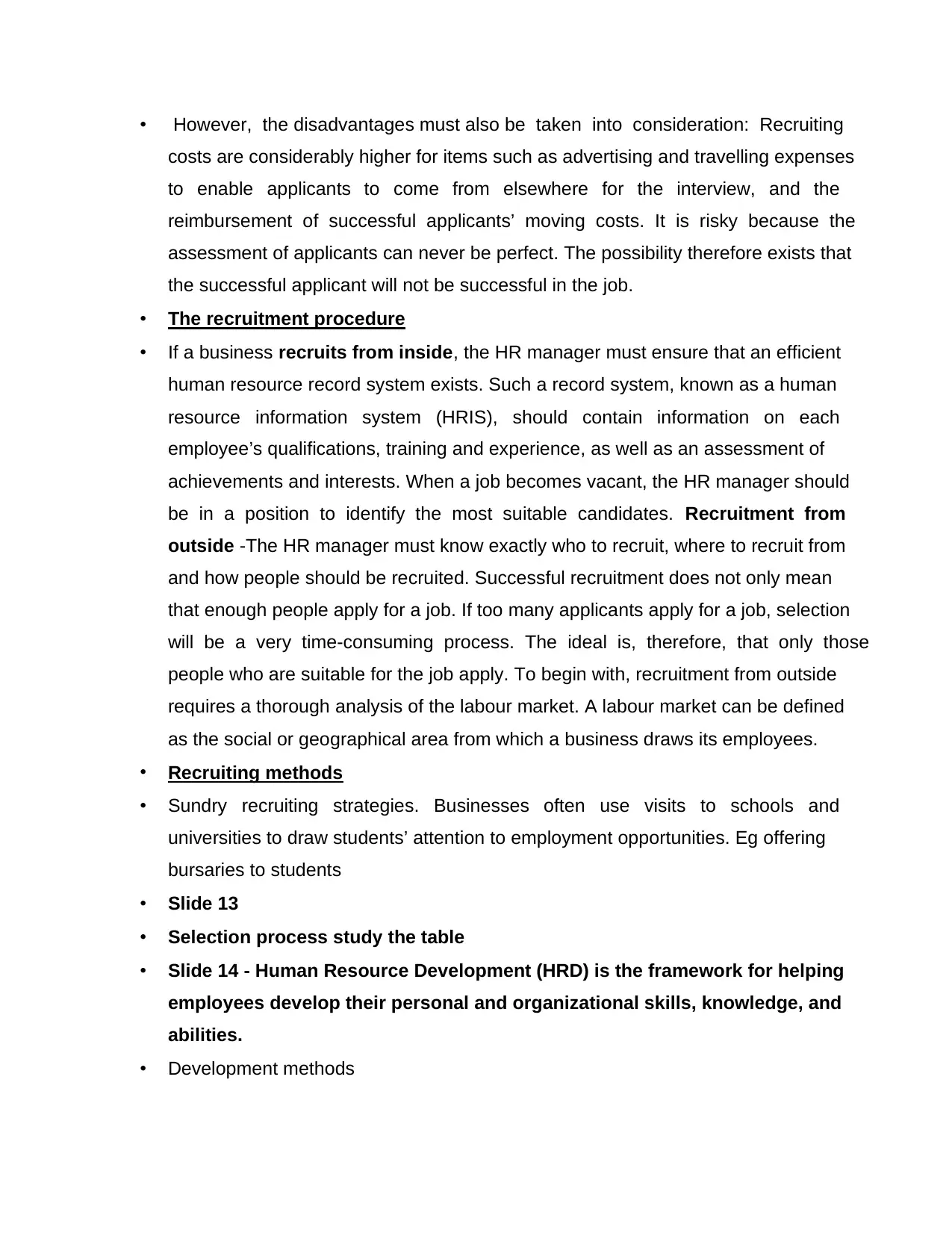
• However, the disadvantages must also be taken into consideration: Recruiting
costs are considerably higher for items such as advertising and travelling expenses
to enable applicants to come from elsewhere for the interview, and the
reimbursement of successful applicants’ moving costs. It is risky because the
assessment of applicants can never be perfect. The possibility therefore exists that
the successful applicant will not be successful in the job.
• The recruitment procedure
• If a business recruits from inside, the HR manager must ensure that an efficient
human resource record system exists. Such a record system, known as a human
resource information system (HRIS), should contain information on each
employee’s qualifications, training and experience, as well as an assessment of
achievements and interests. When a job becomes vacant, the HR manager should
be in a position to identify the most suitable candidates. Recruitment from
outside -The HR manager must know exactly who to recruit, where to recruit from
and how people should be recruited. Successful recruitment does not only mean
that enough people apply for a job. If too many applicants apply for a job, selection
will be a very time-consuming process. The ideal is, therefore, that only those
people who are suitable for the job apply. To begin with, recruitment from outside
requires a thorough analysis of the labour market. A labour market can be defined
as the social or geographical area from which a business draws its employees.
• Recruiting methods
• Sundry recruiting strategies. Businesses often use visits to schools and
universities to draw students’ attention to employment opportunities. Eg offering
bursaries to students
• Slide 13
• Selection process study the table
• Slide 14 - Human Resource Development (HRD) is the framework for helping
employees develop their personal and organizational skills, knowledge, and
abilities.
• Development methods
costs are considerably higher for items such as advertising and travelling expenses
to enable applicants to come from elsewhere for the interview, and the
reimbursement of successful applicants’ moving costs. It is risky because the
assessment of applicants can never be perfect. The possibility therefore exists that
the successful applicant will not be successful in the job.
• The recruitment procedure
• If a business recruits from inside, the HR manager must ensure that an efficient
human resource record system exists. Such a record system, known as a human
resource information system (HRIS), should contain information on each
employee’s qualifications, training and experience, as well as an assessment of
achievements and interests. When a job becomes vacant, the HR manager should
be in a position to identify the most suitable candidates. Recruitment from
outside -The HR manager must know exactly who to recruit, where to recruit from
and how people should be recruited. Successful recruitment does not only mean
that enough people apply for a job. If too many applicants apply for a job, selection
will be a very time-consuming process. The ideal is, therefore, that only those
people who are suitable for the job apply. To begin with, recruitment from outside
requires a thorough analysis of the labour market. A labour market can be defined
as the social or geographical area from which a business draws its employees.
• Recruiting methods
• Sundry recruiting strategies. Businesses often use visits to schools and
universities to draw students’ attention to employment opportunities. Eg offering
bursaries to students
• Slide 13
• Selection process study the table
• Slide 14 - Human Resource Development (HRD) is the framework for helping
employees develop their personal and organizational skills, knowledge, and
abilities.
• Development methods
⊘ This is a preview!⊘
Do you want full access?
Subscribe today to unlock all pages.

Trusted by 1+ million students worldwide
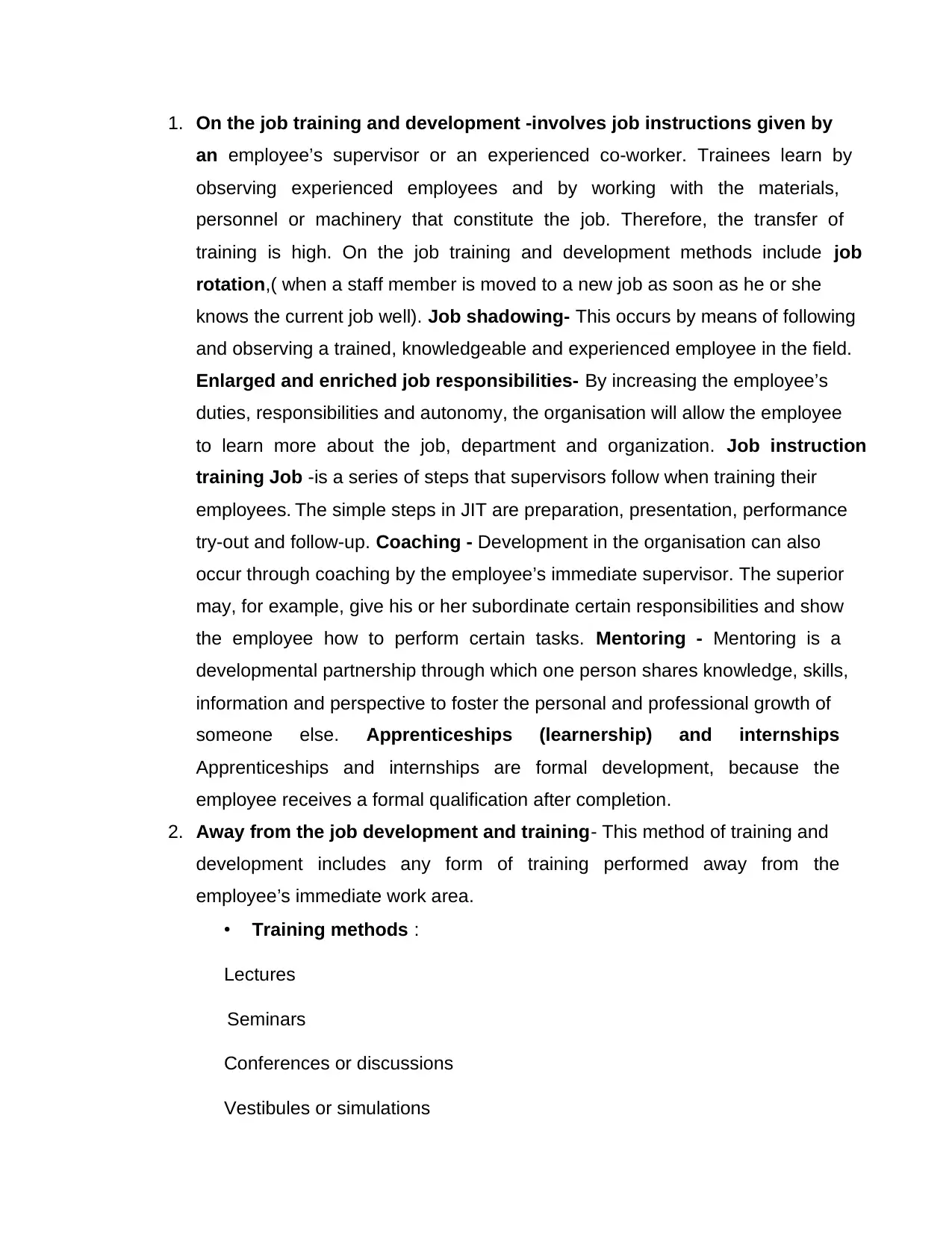
1. On the job training and development -involves job instructions given by
an employee’s supervisor or an experienced co-worker. Trainees learn by
observing experienced employees and by working with the materials,
personnel or machinery that constitute the job. Therefore, the transfer of
training is high. On the job training and development methods include job
rotation,( when a staff member is moved to a new job as soon as he or she
knows the current job well). Job shadowing- This occurs by means of following
and observing a trained, knowledgeable and experienced employee in the field.
Enlarged and enriched job responsibilities- By increasing the employee’s
duties, responsibilities and autonomy, the organisation will allow the employee
to learn more about the job, department and organization. Job instruction
training Job -is a series of steps that supervisors follow when training their
employees. The simple steps in JIT are preparation, presentation, performance
try-out and follow-up. Coaching - Development in the organisation can also
occur through coaching by the employee’s immediate supervisor. The superior
may, for example, give his or her subordinate certain responsibilities and show
the employee how to perform certain tasks. Mentoring - Mentoring is a
developmental partnership through which one person shares knowledge, skills,
information and perspective to foster the personal and professional growth of
someone else. Apprenticeships (learnership) and internships
Apprenticeships and internships are formal development, because the
employee receives a formal qualification after completion.
2. Away from the job development and training- This method of training and
development includes any form of training performed away from the
employee’s immediate work area.
• Training methods :
Lectures
Seminars
Conferences or discussions
Vestibules or simulations
an employee’s supervisor or an experienced co-worker. Trainees learn by
observing experienced employees and by working with the materials,
personnel or machinery that constitute the job. Therefore, the transfer of
training is high. On the job training and development methods include job
rotation,( when a staff member is moved to a new job as soon as he or she
knows the current job well). Job shadowing- This occurs by means of following
and observing a trained, knowledgeable and experienced employee in the field.
Enlarged and enriched job responsibilities- By increasing the employee’s
duties, responsibilities and autonomy, the organisation will allow the employee
to learn more about the job, department and organization. Job instruction
training Job -is a series of steps that supervisors follow when training their
employees. The simple steps in JIT are preparation, presentation, performance
try-out and follow-up. Coaching - Development in the organisation can also
occur through coaching by the employee’s immediate supervisor. The superior
may, for example, give his or her subordinate certain responsibilities and show
the employee how to perform certain tasks. Mentoring - Mentoring is a
developmental partnership through which one person shares knowledge, skills,
information and perspective to foster the personal and professional growth of
someone else. Apprenticeships (learnership) and internships
Apprenticeships and internships are formal development, because the
employee receives a formal qualification after completion.
2. Away from the job development and training- This method of training and
development includes any form of training performed away from the
employee’s immediate work area.
• Training methods :
Lectures
Seminars
Conferences or discussions
Vestibules or simulations
Paraphrase This Document
Need a fresh take? Get an instant paraphrase of this document with our AI Paraphraser
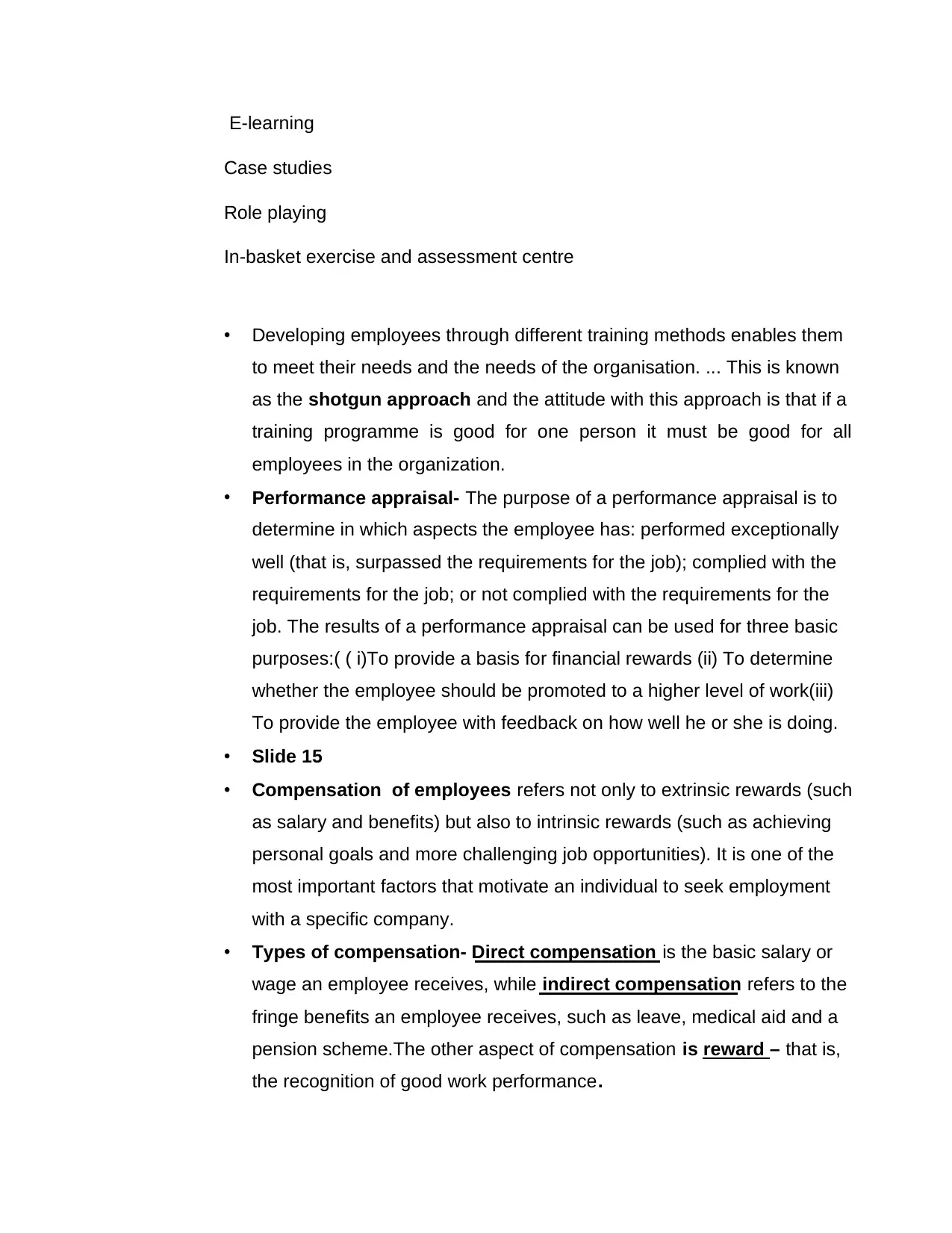
E-learning
Case studies
Role playing
In-basket exercise and assessment centre
• Developing employees through different training methods enables them
to meet their needs and the needs of the organisation. ... This is known
as the shotgun approach and the attitude with this approach is that if a
training programme is good for one person it must be good for all
employees in the organization.
• Performance appraisal- The purpose of a performance appraisal is to
determine in which aspects the employee has: performed exceptionally
well (that is, surpassed the requirements for the job); complied with the
requirements for the job; or not complied with the requirements for the
job. The results of a performance appraisal can be used for three basic
purposes:( ( i)To provide a basis for financial rewards (ii) To determine
whether the employee should be promoted to a higher level of work(iii)
To provide the employee with feedback on how well he or she is doing.
• Slide 15
• Compensation of employees refers not only to extrinsic rewards (such
as salary and benefits) but also to intrinsic rewards (such as achieving
personal goals and more challenging job opportunities). It is one of the
most important factors that motivate an individual to seek employment
with a specific company.
• Types of compensation- Direct compensation is the basic salary or
wage an employee receives, while indirect compensation refers to the
fringe benefits an employee receives, such as leave, medical aid and a
pension scheme.The other aspect of compensation is reward – that is,
the recognition of good work performance.
Case studies
Role playing
In-basket exercise and assessment centre
• Developing employees through different training methods enables them
to meet their needs and the needs of the organisation. ... This is known
as the shotgun approach and the attitude with this approach is that if a
training programme is good for one person it must be good for all
employees in the organization.
• Performance appraisal- The purpose of a performance appraisal is to
determine in which aspects the employee has: performed exceptionally
well (that is, surpassed the requirements for the job); complied with the
requirements for the job; or not complied with the requirements for the
job. The results of a performance appraisal can be used for three basic
purposes:( ( i)To provide a basis for financial rewards (ii) To determine
whether the employee should be promoted to a higher level of work(iii)
To provide the employee with feedback on how well he or she is doing.
• Slide 15
• Compensation of employees refers not only to extrinsic rewards (such
as salary and benefits) but also to intrinsic rewards (such as achieving
personal goals and more challenging job opportunities). It is one of the
most important factors that motivate an individual to seek employment
with a specific company.
• Types of compensation- Direct compensation is the basic salary or
wage an employee receives, while indirect compensation refers to the
fringe benefits an employee receives, such as leave, medical aid and a
pension scheme.The other aspect of compensation is reward – that is,
the recognition of good work performance.
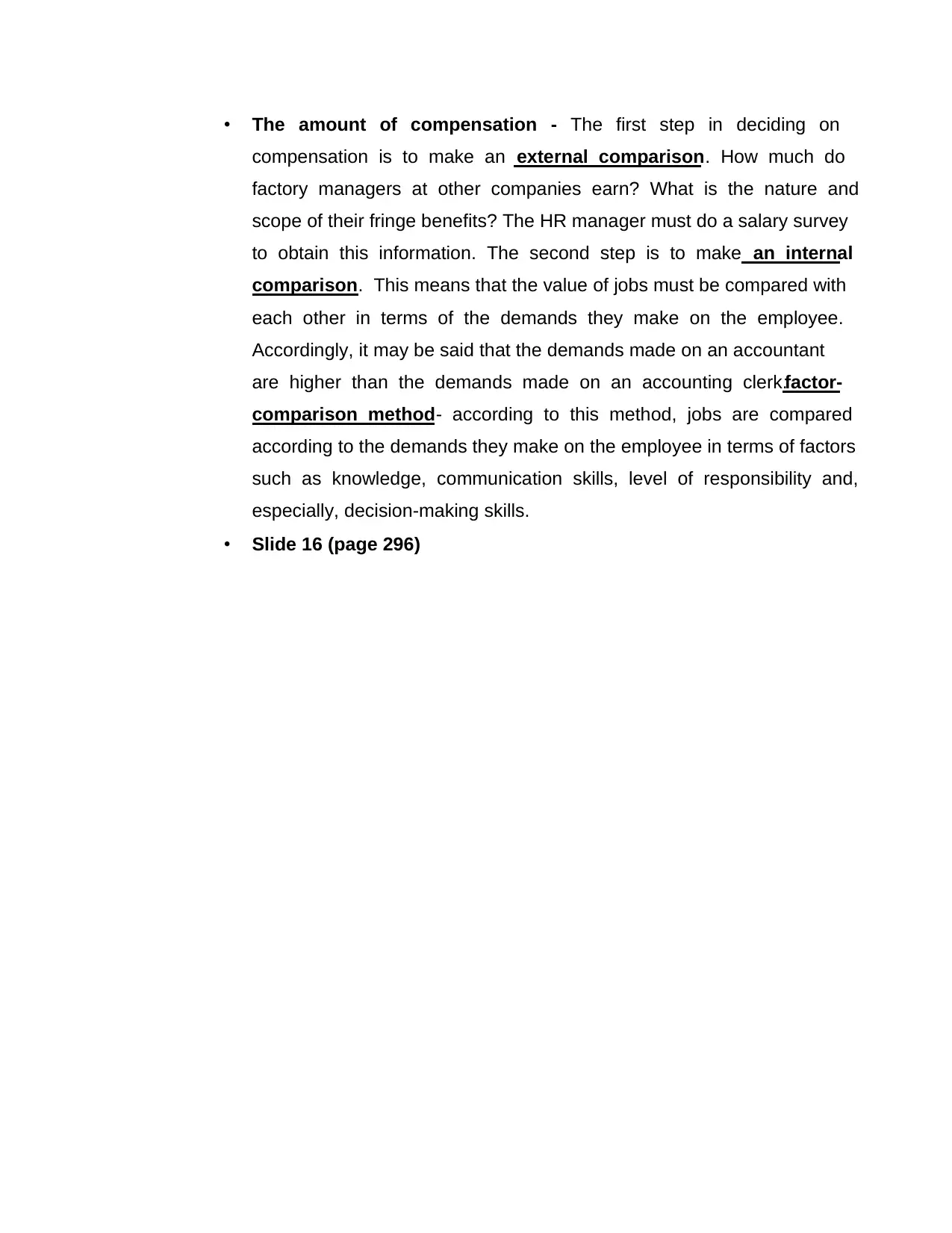
• The amount of compensation - The first step in deciding on
compensation is to make an external comparison. How much do
factory managers at other companies earn? What is the nature and
scope of their fringe benefits? The HR manager must do a salary survey
to obtain this information. The second step is to make an internal
comparison. This means that the value of jobs must be compared with
each other in terms of the demands they make on the employee.
Accordingly, it may be said that the demands made on an accountant
are higher than the demands made on an accounting clerk.factor-
comparison method- according to this method, jobs are compared
according to the demands they make on the employee in terms of factors
such as knowledge, communication skills, level of responsibility and,
especially, decision-making skills.
• Slide 16 (page 296)
compensation is to make an external comparison. How much do
factory managers at other companies earn? What is the nature and
scope of their fringe benefits? The HR manager must do a salary survey
to obtain this information. The second step is to make an internal
comparison. This means that the value of jobs must be compared with
each other in terms of the demands they make on the employee.
Accordingly, it may be said that the demands made on an accountant
are higher than the demands made on an accounting clerk.factor-
comparison method- according to this method, jobs are compared
according to the demands they make on the employee in terms of factors
such as knowledge, communication skills, level of responsibility and,
especially, decision-making skills.
• Slide 16 (page 296)
⊘ This is a preview!⊘
Do you want full access?
Subscribe today to unlock all pages.

Trusted by 1+ million students worldwide
1 out of 9
Related Documents
Your All-in-One AI-Powered Toolkit for Academic Success.
+13062052269
info@desklib.com
Available 24*7 on WhatsApp / Email
![[object Object]](/_next/static/media/star-bottom.7253800d.svg)
Unlock your academic potential
Copyright © 2020–2025 A2Z Services. All Rights Reserved. Developed and managed by ZUCOL.





